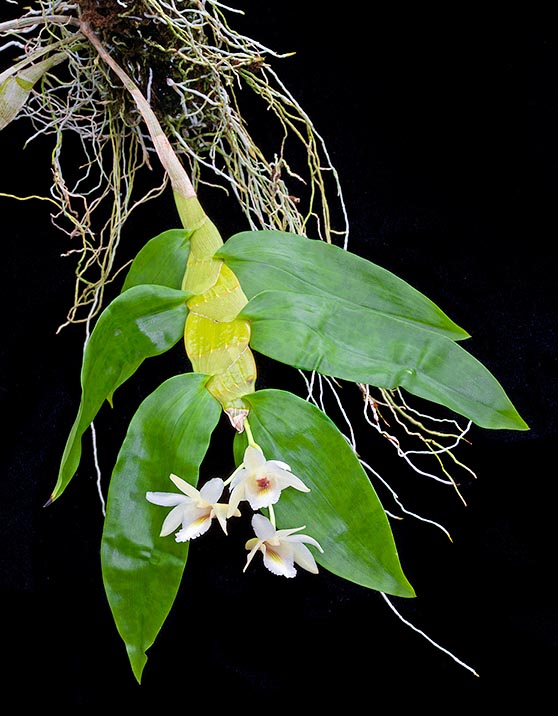Family : Orchidaceae

Text © Pietro Puccio

English translation by Mario Beltramini

Dendrobium platygastrium is a miniature epiphytic orchid. Characteristic 25-35 cm pseudobulbs, laterally flat, thinned at the apex and the base, with deciduous 8-10 cm leaves © Giuseppe Mazza
The name of the genus is the combination of the Greek substantives “δένδρον” (dendron) = tree and “βίος” (bios) = life, with reference to the numerous species of the genus living on the trees; the specific name is the combination of the Greek adjective “πλατύς” (platys) = flat and of the substantive “γαστήρ” (gaster) = stomach, with reference to the shape of the pseudobulbs.
Common names: broad-bellied dendrobium (English).
The Dendrobium platygastrium Rchb.f. (1878) is an epiphytic species with pseudobulbs initially erect tending to become drooping with the time, flattened laterally and tapered at the apex and at the base, 25-35 cm long, 2-2,5 cm broad in the median part and 0,5 cm thick, provided of 6-8 alternate deciduous leaves, distichous, oblong-lanceolate with pointed apex, 8-10 cm long and 2-3 cm broad, turned laterally and coplanar to the pseudobulb, of thin thickness and of pale green colour. Short drooping inflorescences from the apical nodes bearing 3-12 flowers, of about 3 cm of diameter, with yellowish white sepals and petals and white labellum with violaceous spot on the lateral lobes and yellow at the centre of the median lobe. Clavate ovarium 1,3 cm long, elliptic-lanceolate dorsal sepal with pointed apex, 1,3 cm long and 0,4-0,5 cm broad, lateral sepals of the same length as the dorsal merged at the base to form a sort of conical spur (mentum) 1,5 cm long, oblong petals with obtuse apex, 0,8-1,2 cm long and 0,4 cm broad, oblong to subquadrate labellum with wavy margins, 2-2,4 cm long and 1-1,5 cm broad, run at the base by parallel veins.
Miniature orchid with characteristic pseudobulbs and short lasting flowers, 4-8 days, requires a very luminous exposition, with some hours of direct sun per day, medium-high temperatures, 22-32 °C, high humidity, 70-85%, and constant movement of air. Regular and abundant waterings when in vegetation, more spaced during the vegetative rest, but without letting the pseudobulbs to wrinkle too much, utilizing rain water, demineralized or by reverse osmosis. Monthly fertilizations during the growth utilizing a balanced hydrosoluble product, with microelements, at ¼ the dosage suggested on the package. For the posture, basically drooping, is usually mounted on trunks, bark, rafts of cork or of roots of arborescent ferns. The transplants, when necessary, are to be done at the vegetative restart.

Short drooping inflorescences from the apical nodes bearing 3-12 short lasting flowers of 3 cm of diameter. The species is native to Fiji, Solomon, Santa Cruz, New Caledonia, New Guinea, Tonga and Vanuatu islands where grows on the humid forests trees from the sea level up to about 1000 m of altitude © Giuseppe Mazza
Synonyms: Callista platygastria (Rchb.f.) Kuntze (1891); Dendrobium camptocentrum Schltr. (1906); Pedilonum camptocentrum (Schltr.) Rauschert (1983); Pedilonum platygastrium (Rchb.f.) Rauschert (1983); Eurycaulis camptocentrus (Schltr.) M.A.Clem. & D.L.Jones (2002); Eurycaulis platygastrius (Rchb.f.) M.A.Clem. (2003).
→ For general notions about ORCHIDACEAE please click here.
